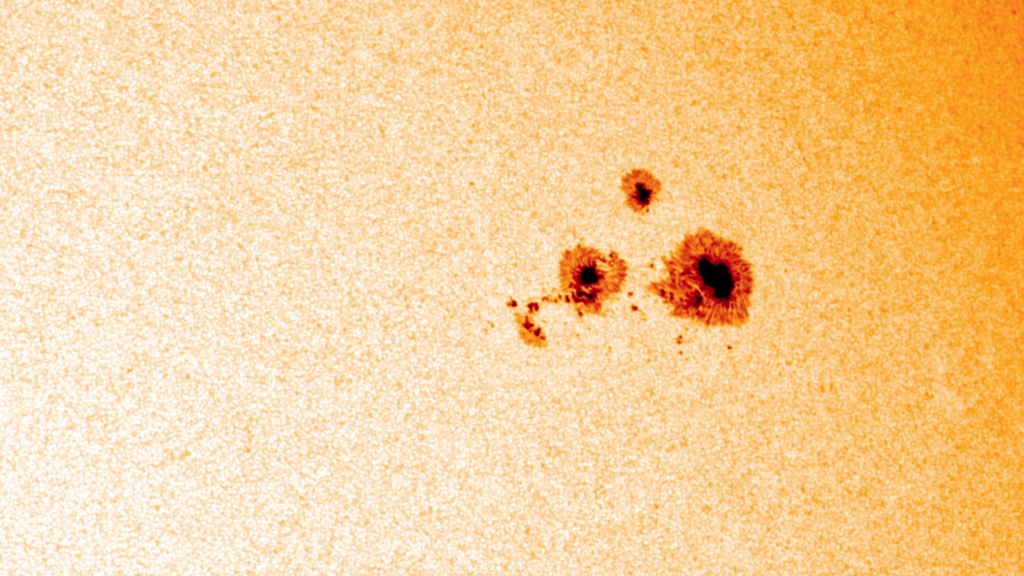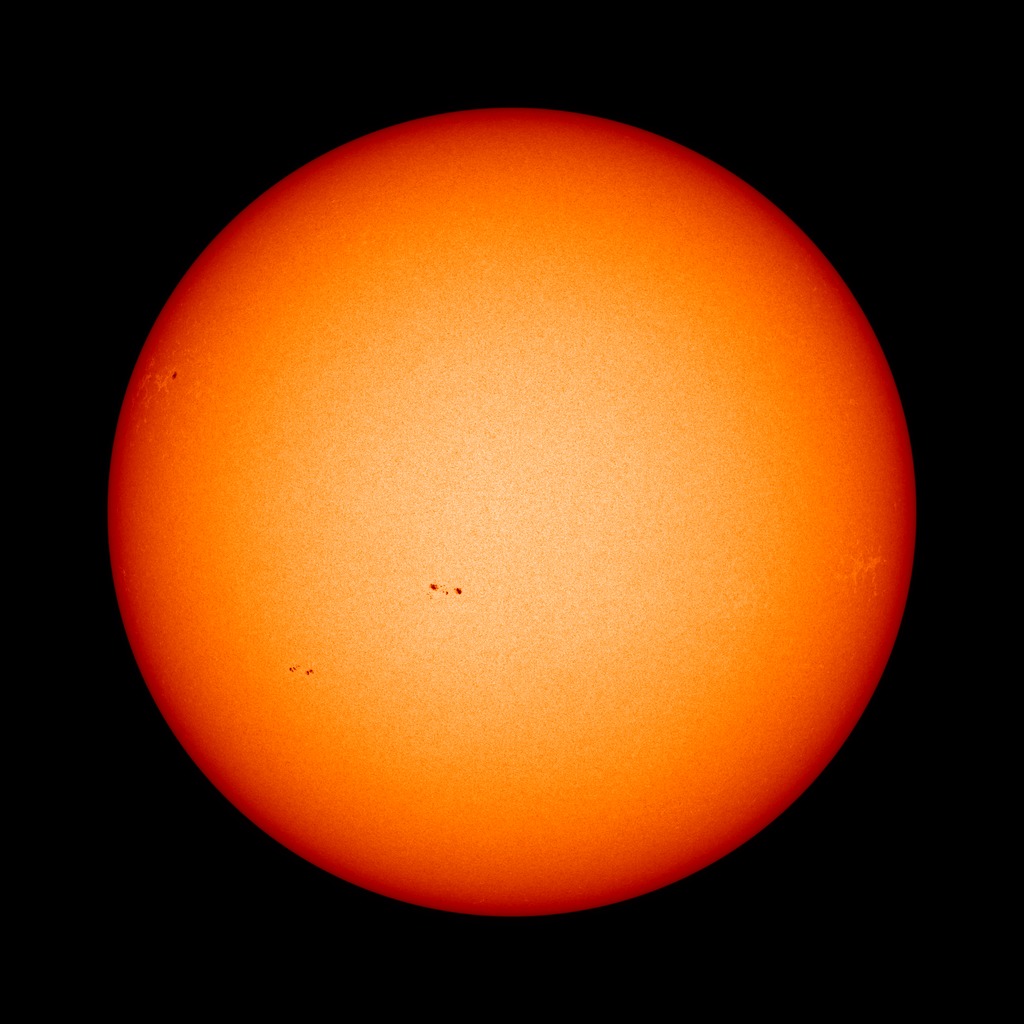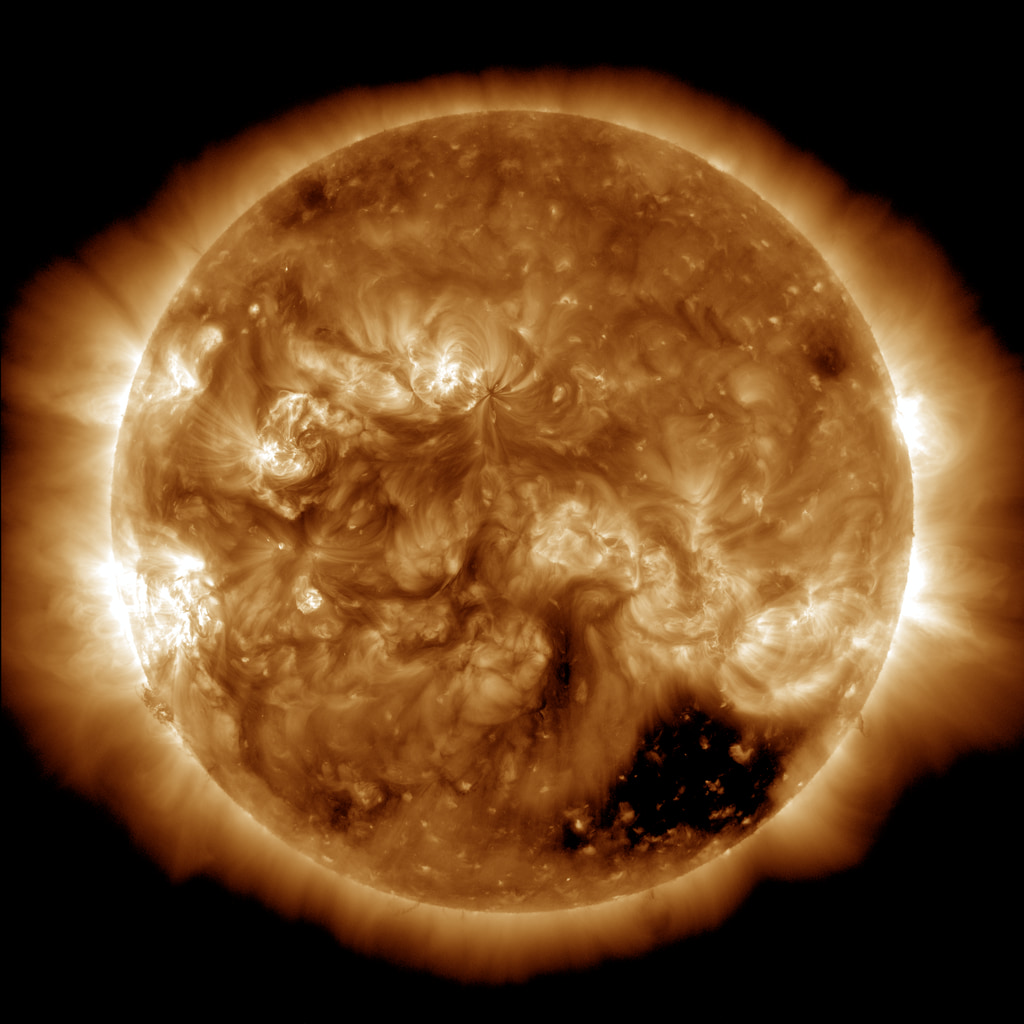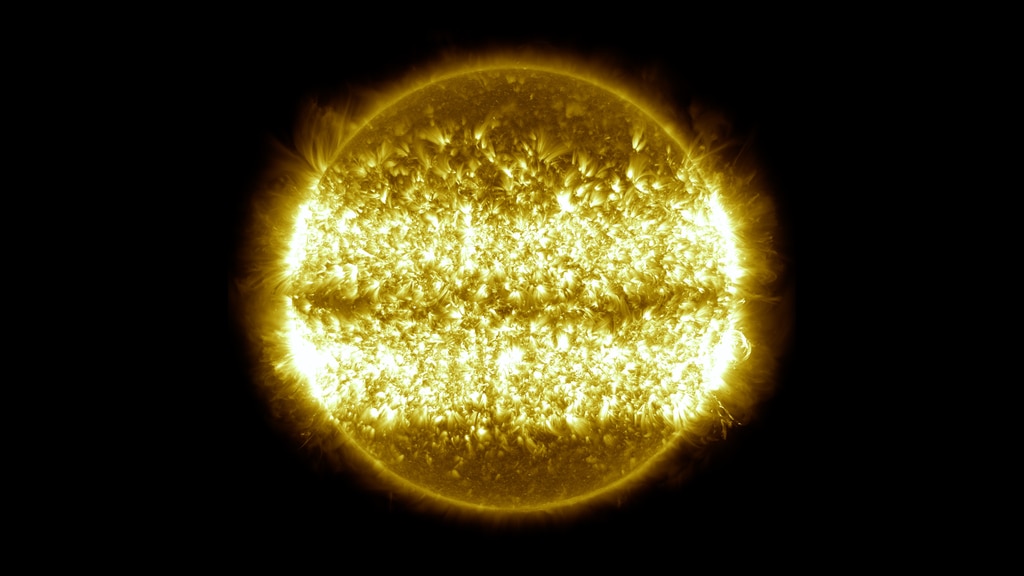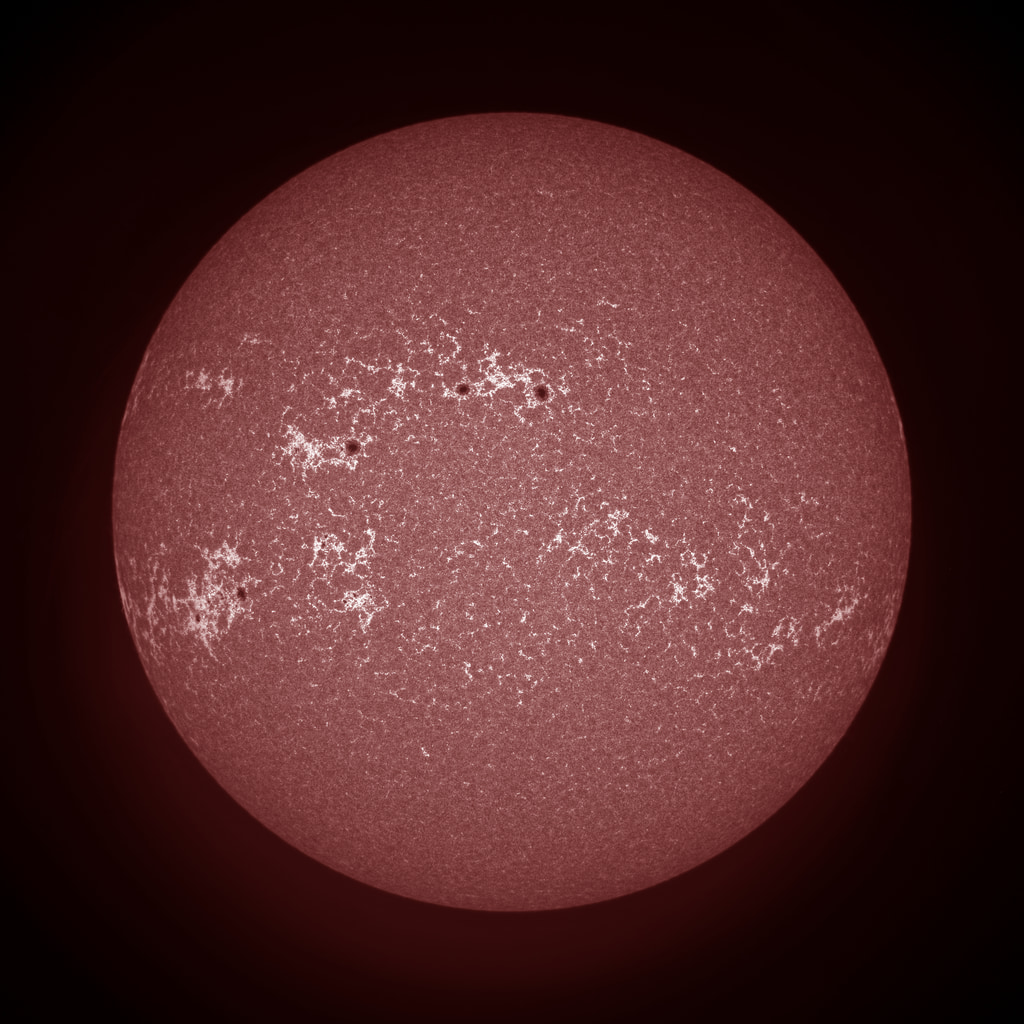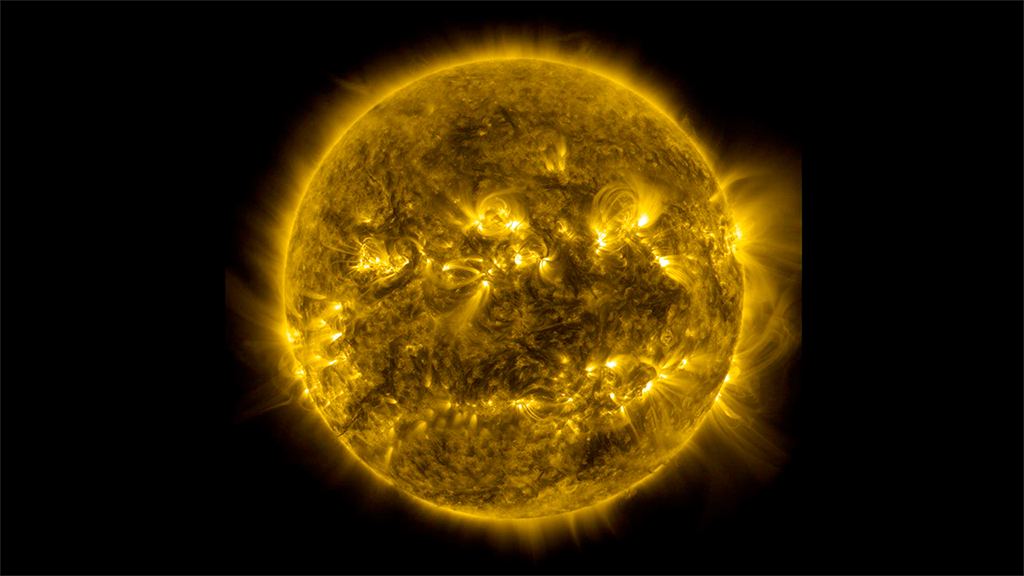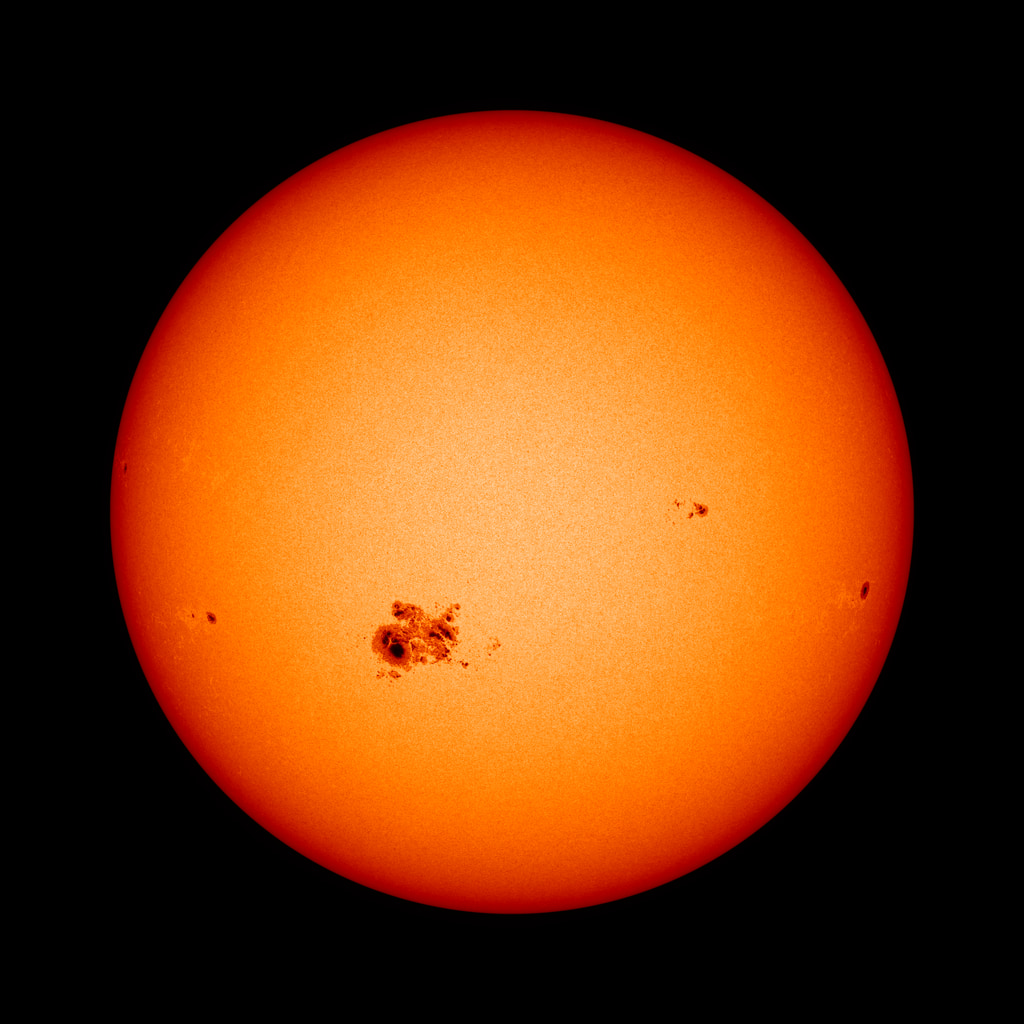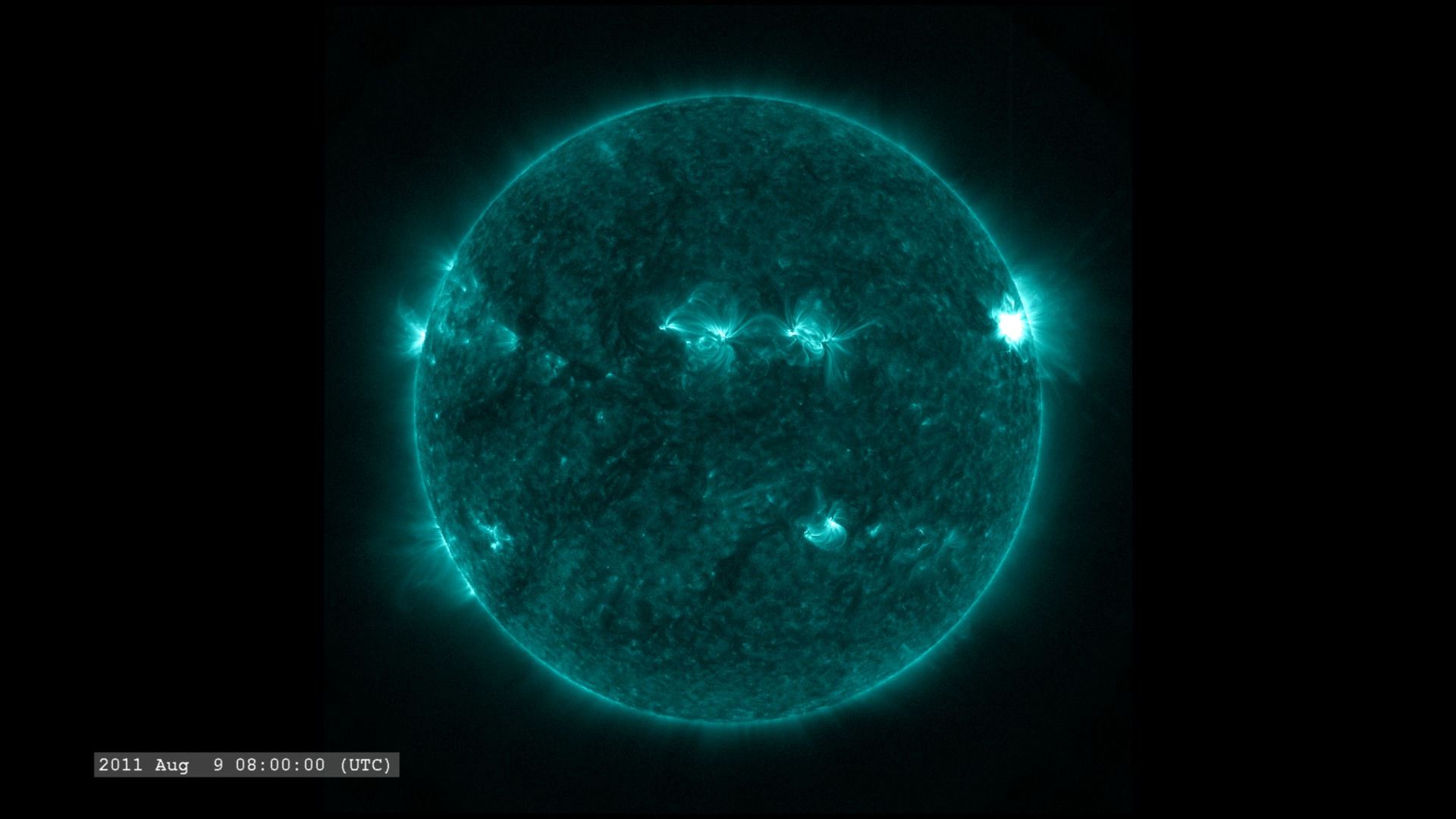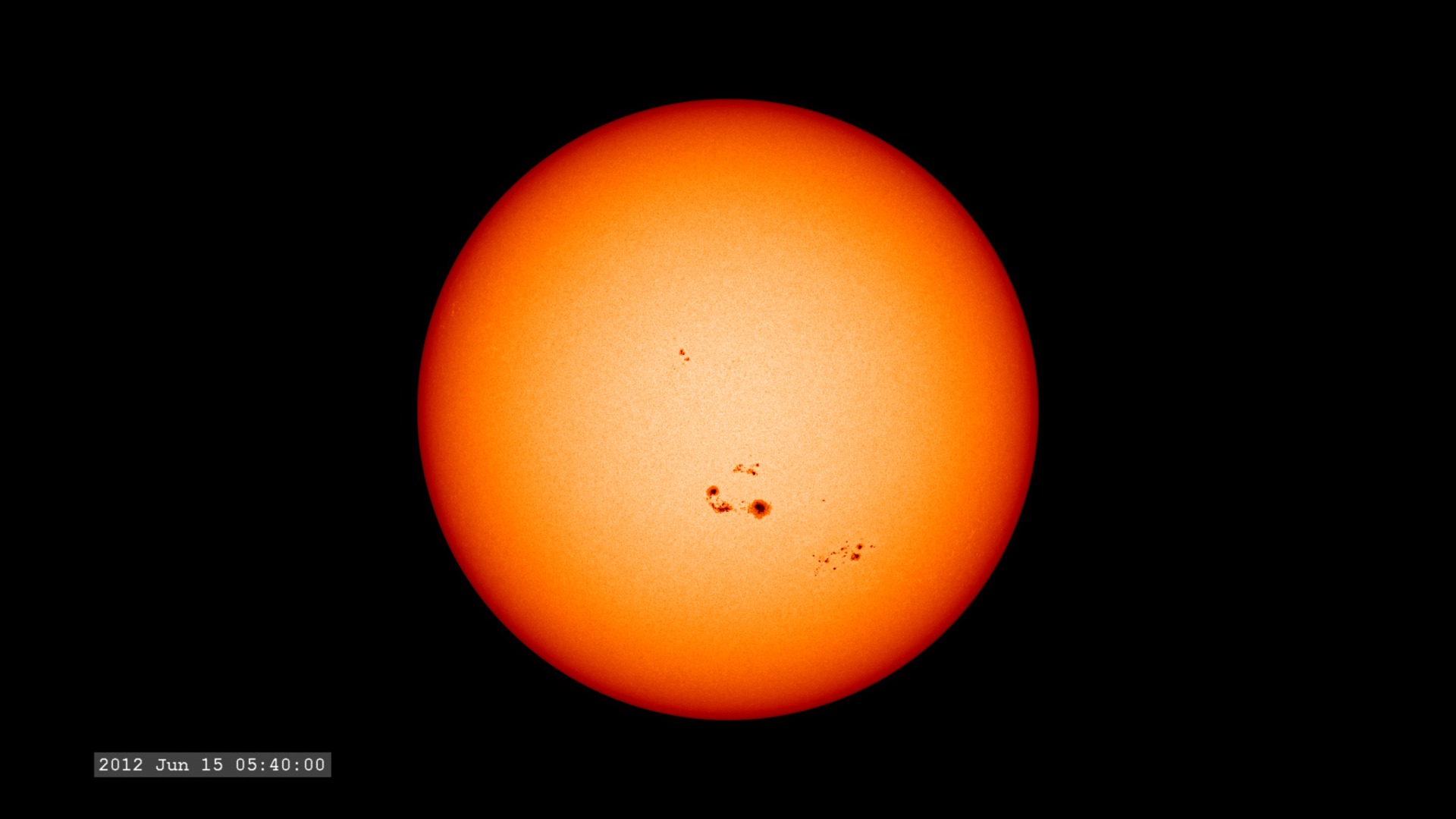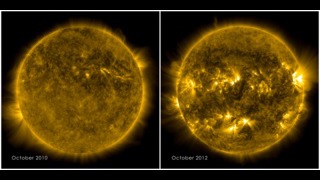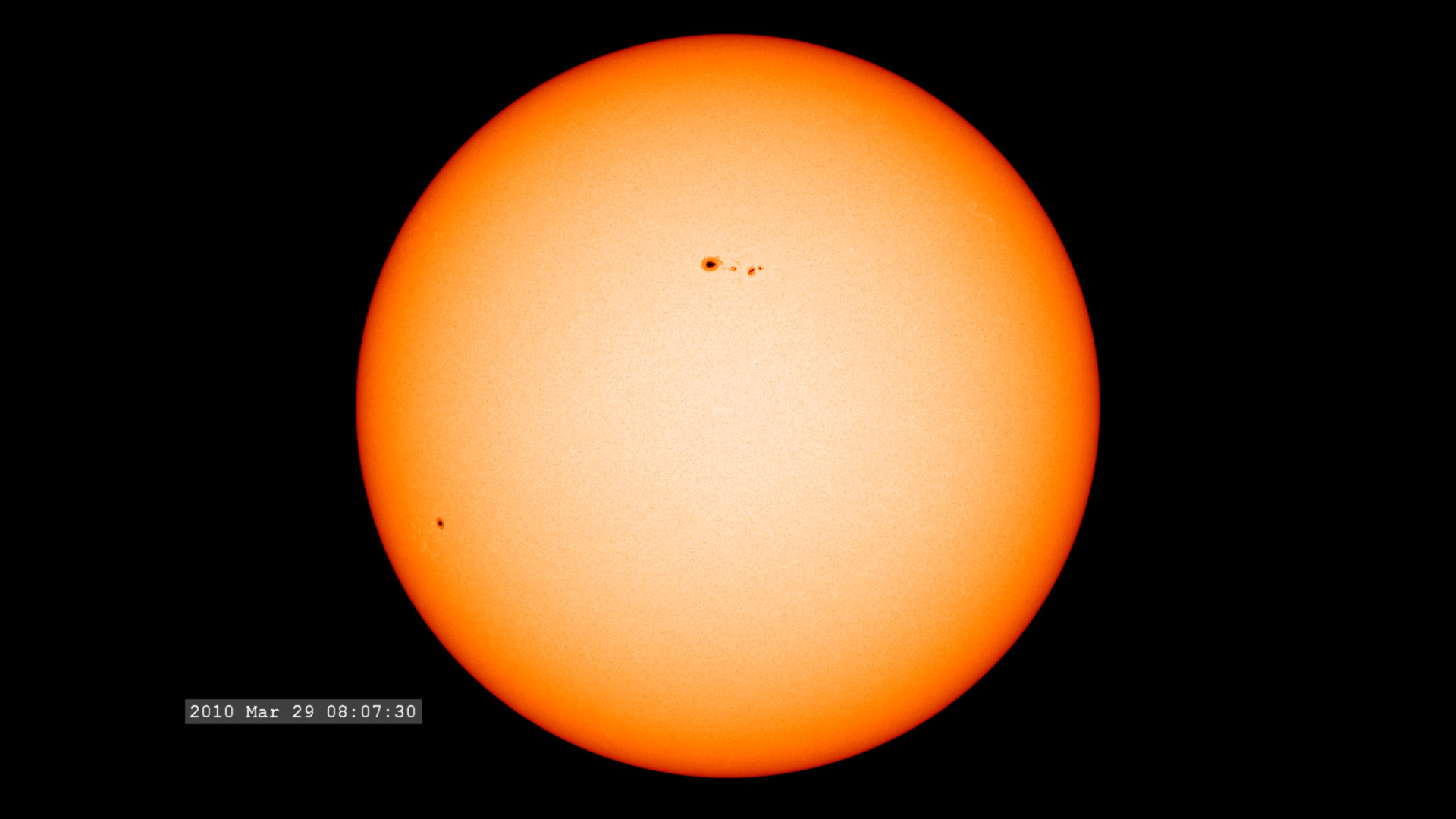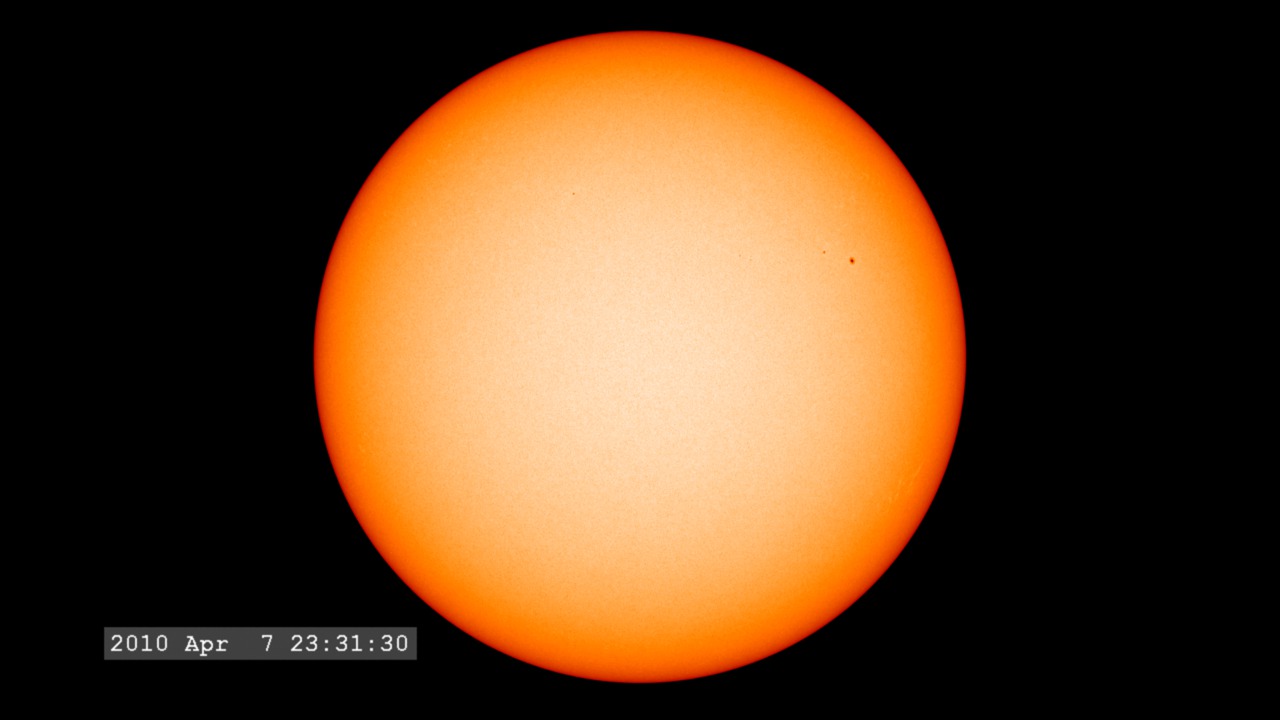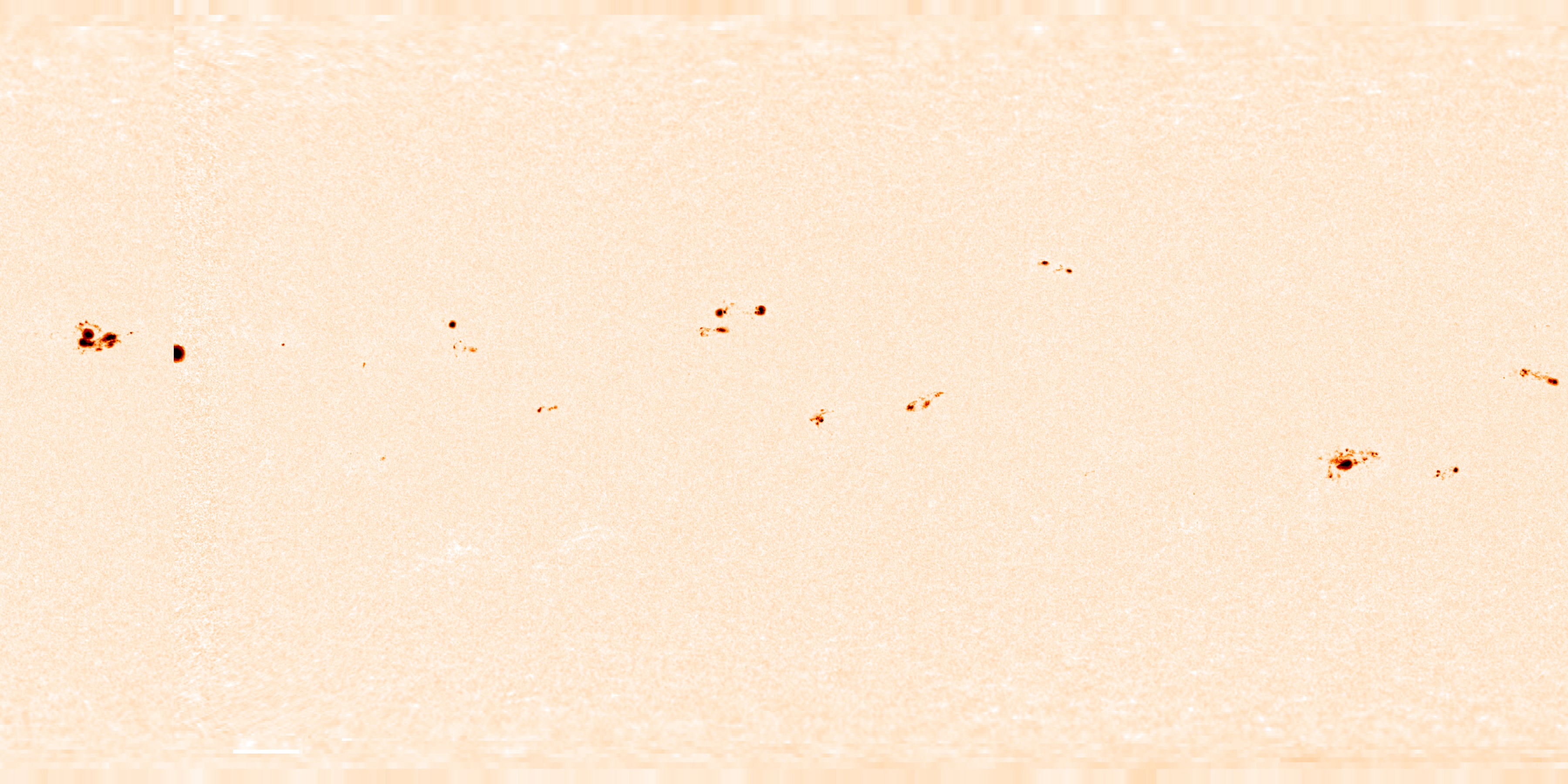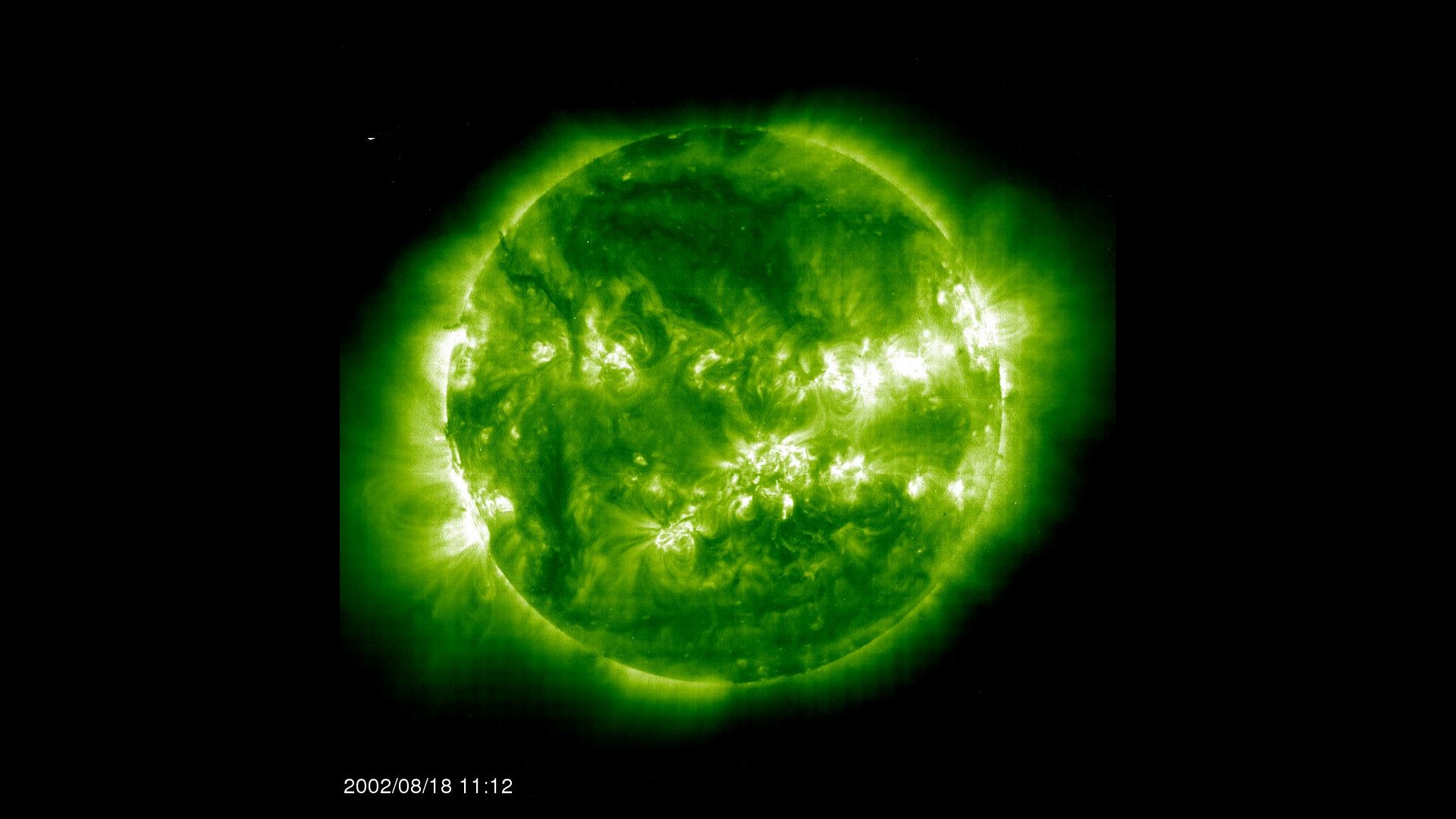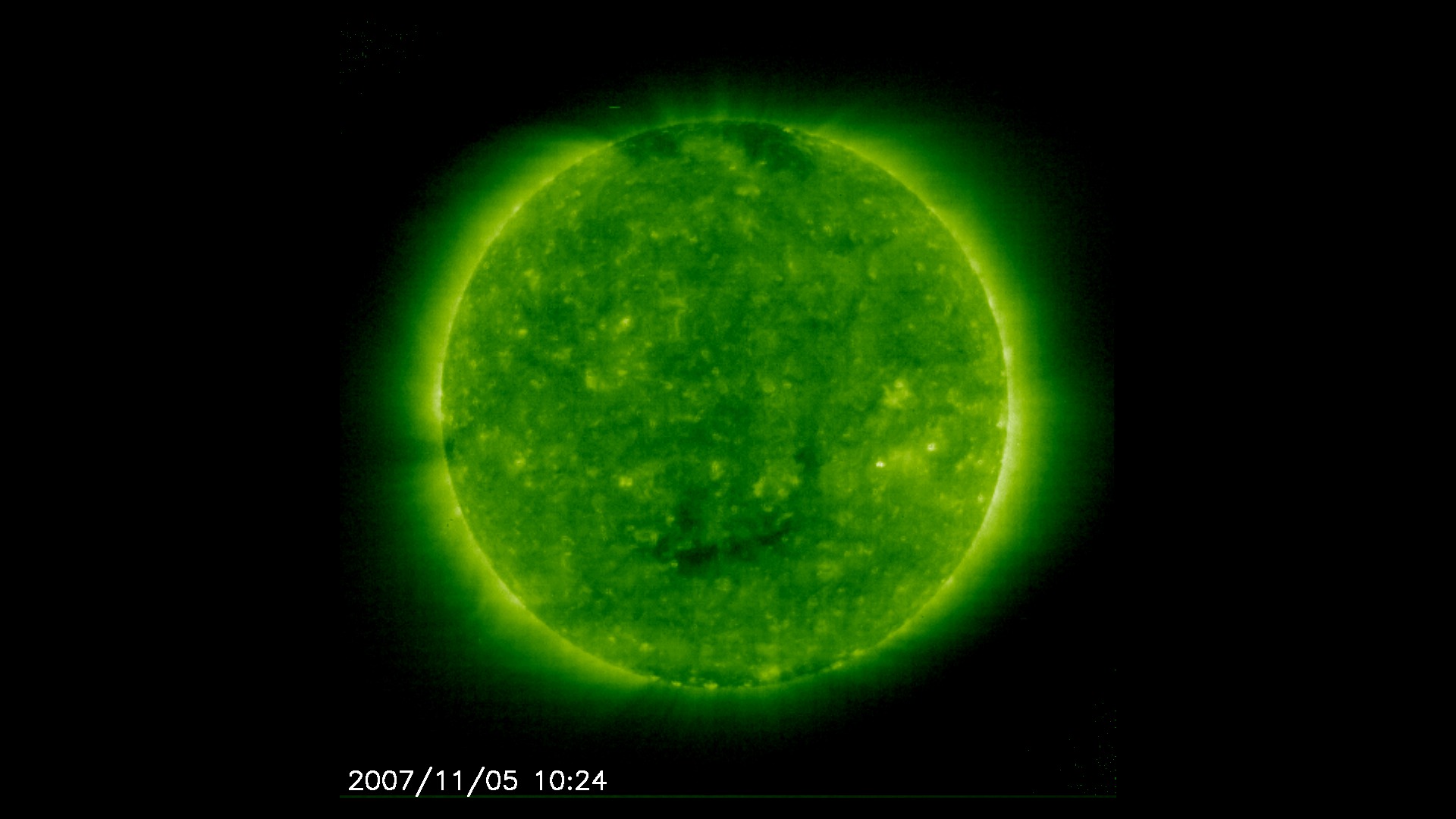Solar Cycle 25
Overview
The Solar Cycle 25 Prediction Panel, an international group of experts co-sponsored by NASA and the National Oceanic and Atmospheric Administration (NOAA), announced that solar minimum occurred in December 2019, marking the start of Solar Cycle 25. Since then, the Sun’s activity has been steadily increasing as it approaches solar maximum — the peak of Solar Cycle 25.
A new solar cycle comes roughly every 11 years. Over the course of each cycle, the Sun transitions from relatively calm to active and stormy, and then quiet again. At its peak, the Sun’s magnetic poles flip.
Understanding the Sun’s behavior is an important part of life in our solar system. The Sun’s outbursts, including eruptions known as solar flares and coronal mass ejections, can disturb satellites and communication signals traveling around Earth. Scientists study the solar cycle so we can better understand and predict solar activity.
MEDIA RESOURCES
NASA, NOAA Announce That the Sun Has Reached the Solar Maximum Period
Go to this pageIn a teleconference with reporters on Tuesday, October 15, 2024, representatives from NASA, the National Oceanic and Atmospheric Agency (NOAA), and the Solar Cycle Prediction Panel announced the Sun has reached its solar maximum period.The solar cycle is the natural cycle of the Sun as it transitions between low and high activity. Roughly every 11 years, at the height of the solar cycle, the Sun’s magnetic poles flip — on Earth, that’d be like the North and South Poles swapping places every decade — and the Sun transitions from sluggish to active and stormy.During the most active part of the cycle, known as solar maximum, the Sun can unleash immense explosions of light, energy, and solar radiation — all of which create conditions known as space weather. Space weather can affect satellites and astronauts in space, as well as communications systems — such as radio and GPS — and power grids on Earth. When the Sun is most active, space weather events become more frequent. Solar activity, such as the storm in May 2024, has led to increased aurora visibility and impacts on satellites and infrastructure in recent months.Listen to the media telecon.Read NASA's article about the news. ||
Solar Cycle 25 Is Here. NASA, NOAA Scientists Explain What This Means
Go to this pageSolar Cycle 25 has begun. The Solar Cycle 25 Prediction Panel announced solar minimum occurred in December 2019, marking the transition into a new solar cycle. In a press event, experts from the panel, NASA, and NOAA discussed the analysis and Solar Cycle 25 prediction, and how the rise to the next solar maximum and subsequent upswing in space weather will impact our lives and technology on Earth.A new solar cycle comes roughly every 11 years. Over the course of each cycle, the star transitions from relatively calm to active and stormy, and then quiet again; at its peak, the Sun’s magnetic poles flip. Now that the star has passed solar minimum, scientists expect the Sun will grow increasingly active in the months and years to come.Understanding the Sun’s behavior is an important part of life in our solar system. The Sun’s outbursts—including eruptions known as solar flares and coronal mass ejections—can disturb the satellites and communications signals traveling around Earth, or one day, Artemis astronauts exploring distant worlds. Scientists study the solar cycle so we can better predict solar activity.Click here for the NOAA press kit.Listen to the media telecon.Participants:• Lisa Upton, Co-chair, Solar Cycle 25 Prediction Panel; Solar Physicist, Space Systems Research Corporation• Doug Biesecker, Solar Physicist, NOAA’s Space Weather Prediction Center; Co-chair, Solar Cycle 25 Prediction Panel• Elsayed Talaat, Director, Office of Projects, Planning and Analysis; NOAA’s Satellite and Information Service • Lika Guhathakurta, Heliophysicist, Heliophysics Division, NASA Headquarters • Jake Bleacher, Chief Exploration Scientist, NASA Human Exploration and Operations Mission Directorate ||
NASA/NOAA Interview Opportunity: Space Weather live shots
Go to this pageClick here for NOAA's Solar Minimum Press Kit with downloadable imagery and b-roll.Cut b-roll for the live shots will be posted Tuesday, Sept 15 by 4:00 p.m. EST || SolarBanner5.jpg (382x2448) [463.6 KB] || SolarBanner5_print.jpg (1024x159) [164.0 KB] || SolarBanner5_searchweb.png (320x180) [93.2 KB] || SolarBanner5_thm.png (80x40) [18.1 KB] ||
2020 AGU Roundtable: What will we learn from Solar Cycle 25?
Go to this pageSolar Cycle 25 is here, ushering in the next season of space weather from the Sun. As our star’s activity ramps up—a natural part of its roughly 11-year cycle—scientists are eager to test their predictions. In this AGU 2020 media roundtable, scientists will discuss outstanding questions in solar cycle science, what opportunities this new cycle provides researchers, and how we track progress in predictions. ||
SIGNIFICANT SOLAR ACTIVITY FROM SOLAR CYCLE 25
Largest Flare yet from Solar Cycle 25
Go to this pageOn May 14, 2024, the Sun emitted a strong solar flare. This solar flare is the largest of Solar Cycle 25 and is classified as an X8.7 flare. X-class denotes the most intense flares, while the number provides more information about its strength.A solar flare is an intense burst of radiation, or light, on the Sun. Flares are our solar system’s most powerful explosive events. Light only takes about 8 minutes to travel from the Sun to Earth, so that’s how long it would take the energy from a flare to reach our planet. Stronger solar flares — those rated class M5 or above — can have impacts on technology that depends on Earth’s ionosphere (our electrically charged upper atmosphere), like high-frequency radio used for navigation and GPS.NASA’s Solar Dynamics Observatory (SDO) captured these images of the flare, which peaked at 12:51 p.m. ET on May 14. The X8.7 flare appears on the lower right edge of the Sun. (A small eruption appears afterward in the upper left.) SDO sees the Sun in more than 10 distinct wavelengths of light, showing solar material at different temperatures. Different wavelengths are shown in this video to highlight different features of the flare.Music credit: “Ethereal Mirrorscape” from the album Reflections written and produced by Lars LeonhardWatch this video on the NASA Goddard YouTube channel.Complete transcript available. || X8pt7_flare_May_14_2024.00_00_40_22.Still001.jpg (3840x2160) [3.0 MB] || X8pt7_flare_May_14_2024.00_00_40_22.Still001_print.jpg (1024x576) [342.3 KB] || X8pt7_flare_May_14_2024.00_00_40_22.Still001_searchweb.png (320x180) [75.1 KB] || X8pt7_flare_May_14_2024.00_00_40_22.Still001_web.png (320x180) [75.1 KB] || X8pt7_flare_May_14_2024.00_00_40_22.Still001_thm.png (80x40) [6.1 KB] || 14592_SDO_X8pt7_flare_May_14_2024_ProRes_Outro.webm (3840x2160) [20.4 MB] || 14592_SDO_X8pt7_flare_May_14_2024_Good_Outro.mp4 (3840x2160) [175.9 MB] || 14592_SDO_X8pt7_flare_May_14_2024_YouTube_Outro.mp4 (3840x2160) [673.0 MB] || 14592_SDO_X8pt7_flare_May_14_2024_ProRes_Outro.mov (3840x2160) [4.2 GB] ||
May 2-10, 2024 : A Busy Week of Flares
Go to this pageProduced VideoWatch this video on the NASA Goddard YouTube channel.Music Credit: “Halos” from the album Burning Clouds. Written and produced by Lars Leonhard. https://ultimae.bandcamp.com/track/halos || 14588_FlareRecap_thumbnail.jpg (1280x720) [205.8 KB] || 14588_FlareRecap_X.mp4 (1920x1080) [138.1 MB] || 14588_FlareRecap_YT.mp4 (1920x1080) [337.5 MB] || 14588FlareRecapCaptions.en_US.srt [1.5 KB] || 14588FlareRecapCaptions.en_US.vtt [1.4 KB] || 14588_FlareRecap_ProRes.mov (1920x1080) [3.2 GB] ||
Continuing Strong Solar Flares: May 15-16, 2024
Go to this pageDuring the week of May 10 to May 16, 2024, NASA’s Solar Dynamics Observatory (SDO) observed nine X-class solar flares erupting from the Sun, including the largest in this solar cycle to date on May 14 that peaked at X8.7.This video shows these flares using SDO observations in two wavelengths of extreme ultraviolet light, 131 angstroms (colorized as teal) and 171 angstroms (colorized as gold).These flares originated primarily from an active region on the Sun called AR 13664. This region, along with another called AR 13663, was responsible for the majority of strong solar flares from May 3 through May 9.Watch this video on the NASA Goddard YouTube channel.Music credit: "Collab Alert" by Ellis Kent [PRS] from Universal Production Music || Thumbnail02.jpg (1280x720) [818.1 KB] || 14593_X-ClassFlaresDominateSunInMay_1080_YouTube.mp4 (1920x1080) [221.9 MB] || XClassFlares.en_US.srt [1.4 KB] || XClassFlares.en_US.vtt [1.3 KB] || 14593_X-ClassFlaresDominateSunInMay_4K_Facebook.mp4 (3840x2160) [328.8 MB] || 14593_X-ClassFlaresDominateSunInMay_4K_YouTube.mp4 (3840x2160) [539.4 MB] || 14593_X-ClassFlaresDominateSunInMay_4K_ProRes_.mov (3840x2160) [7.2 GB] ||
Sun Releases 50th X flare of Solar Cycle 25, Quickly Followed by Two More
Go to this pageNASA’s Solar Dynamics Observatory captured this image of a solar flare – as seen in the bright eruption on the lower left – at 22:03 UTC on May 31, 2024. The image shows a blend of 131 Angstrom and 304 Angstrom light, subsets of extreme ultraviolet light. Credit: NASA/SDO || SDO_May31_2024_2204_131_304_2.jpg (4096x4096) [2.9 MB] || SDO_May31_2024_2204_131_304_2_searchweb.png (320x180) [83.2 KB] || SDO_May31_2024_2204_131_304_2_thm.png (80x40) [6.2 KB] ||
DATA VISUALIZATIONS
The Solar Polar Magnetic Field
Go to this pageFrom our single vantage point of Earth, our view of the Sun is never complete. While the far-side of the Sun eventually rotates into view, coverage of the Sun's polar regions is never satisfactory as perspective effects either completely block our view or create a distorted view. We must often resort to computer modeling of these solar polar regions.This visualization presents the Potential Field Source Surface (PFSS) magnetic field model based on solar observations covering the years 2017-2019. One version also presents the 'hole' in our measurements of the solar polar region. The region oscillates in size over the course of the year due to the changing perspective created by the tilt of Earth's orbital plane with the solar equator. In this region, researchers must resort to approximations to build a more complete view of the solar magnetic field.Why is the solar magnetic field in this region important? Because the combined with the outgoing flow of the solar wind, the magnetic field lines from the polar regions curve up, and then back down to near the Sun's equatorial plane, which is still fairly close to the orbital plane of Earth and other planets in our solar system. This gives the Sun's polar magnetic field a significant influence on the space weather impacting Earth and crewed and uncrewed assets around the solar system. ||
The Sun's Magnetic Field
Go to this pageDuring the course of the approximately 11 year sunspot cycle, the magnetic field of the Sun reverses. The last time this happened was around the year 2000. Using magnetograms from the SOHO/MDI and SDO/HMI instruments, it is possible to examine possible configurations of the magnetic field above the photosphere. These magnetic configurations are important in understanding potential conditions of severe space weather.The magnetic field in this animation is constructed using the Potential Field Source Surface (PFSS) model. The PFSS model is one of the simplest yet realistic models we can explore. Using the solar magnetograms as the 'source surface' of the field, it builds the field structure from the photosphere out to about two solar radii (an altitude of 1 solar radius). These visuals were generated using the SolarSoft package. In this visualization, the white magnetic field lines are considered 'closed'. The move up, and then return to the solar surface. The green and violet lines represenent field lines that are considered 'open'. Green represents positive magnetic polarity, and violet represents negative polarity. These field lines do not connect back to the Sun but with more distant magnetic fields in space. These field lines act as easy 'roads' for the high-speed solar wind. ||
The Solar Dynamo: Toroidal and Poloidal Magnetic Fields
Go to this pageUsing the solar plasma flows as input (see The Solar Dynamo: Plasma Flows), the equations of magnetohydrodynamics, and 'seeding' the calculations with an initial small magnetic field, one can compute how a magnetic field can grow and be maintained. This is the dynamo process, the net result being that part of the Sun's outflowing thermal convective energy from nuclear processes is used to create the magnetic field.In this view of the solar dynamo mechanism, we examine the evolution of the toroidal magnetic field, the field intensity represented by colors on the right-hand cross-section, and the poloidal magnetic potential field, represented by colors on the left-hand cross-section. The poloidal magnetic potential is a scalar quantity that contains information about the radial and latitudinal magnetic field vectors. To see the radial magnetic field, see The Solar Dynamo: Toroidal and Radial Magnetic Fields.In this visualization, the magnetic field lines (represented by the 'copper wire' structures) are 'snapshots' of the field structure constructed at each time step of the model. These field lines should not be considered as 'moving' or 'stretching' as the model evolves in time. Even this simplified model reproduces a number of characteristics observed in the actual solar magnetic field. Cyclic behavior with oscillations in the magnetic field amplitude.Magnetic regions at the surface migrate from high latitudes towards the equator as the solar cycle progresses. This reproduces the "Butterfly Diagram" pattern.Surface magnetic polarities reverse with each cycleBecause this model is axisymmetric, it cannot simulate non-axisymmetric features such as active longitudes. ||
The Solar Dynamo: Toroidal and Radial Magnetic Fields
Go to this pageUsing the solar plasma flows as input (see The Solar Dynamo: Plasma Flows), the equations of magnetohydrodynamics, and 'seeding' the calculations with an initial small magnetic field, one can compute how a magnetic field can grow and be maintained. This is the dynamo process, the net result being that part of the Sun's outflowing thermal convective energy from nuclear processes is used to create the magnetic field.In this view of the solar dynamo mechanism, we examine the evolution of the toroidal magnetic field, intensities represented by color on the right-hand cross-section, and the radial magnetic field, represented on the left-hand cross-section. To see the poloidal magnetic vector potential, see The Solar Dynamo: Toroidal and Poloidal Magnetic Fields.In this visualization, the magnetic field lines (represented by the 'copper wire' structures) are 'snapshots' of the field structure constructed at each time step of the model. These field lines should not be considered as 'moving' or 'stretching' as the model evolves in time.Even this simplified model reproduces a number of characteristics observed in the actual solar magnetic field.Cyclic behavior with oscillations in the magnetic field amplitude.Magnetic regions at the surface migrate from high latitudes towards the equator. This reproduces the "Butterfly Diagram" pattern.Surface magnetic polarities reverse with each cycleBecause this model is axisymmetric, it cannot simulate non-axisymmetric features such as active longitudes. ||
Pole Reversal
Go to this pageLike a bar magnet, the sun has a magnetic north and south pole. The comparison to a simple bar magnet ends there, however, as the sun's magnetic fields are on the move. In fact, approximately every 11 years the polarity of the sun’s northern and southern hemisphere flips. This change is part of a regular cycle called the solar cycle. Each cycle is defined by periods of high and low solar activity caused by the movement of magnetic field lines that extend out from the sun. Now, a new animation created from data collected by the ESA/NASA SOHO spacecraft shows how migrating magnetic field lines result in a reversal of the sun’s polarity. Watch the video to see the evolution of the sun’s magnetic field from January 1997 to December 2013. ||
The Dynamic Solar Magnetic Field
Go to this pageA visualization of the slow changes of the solar magnetic field over the course of four years. || PFSSbasicView_inertial.HD1080i.0400_print.jpg (1024x576) [168.7 KB] || PFSSbasicView_inertial.HD1080i.0400_searchweb.png (180x320) [78.9 KB] || PFSSbasicView_inertial.HD1080i.0400_thm.png (80x40) [5.8 KB] || PFSSbasicView_inertial_1080p30.webm (1920x1080) [18.1 MB] || PFSSbasicView (1920x1080) [128.0 KB] || PFSSbasicView_inertial_1080p30.mp4 (1920x1080) [326.6 MB] || PFSSbasicView_inertial_1080p10.mp4 (1920x1080) [470.2 MB] || PFSSbasicView_HD1080p10.mov (1920x1080) [804.4 MB] || PFSSbasicView_inertial_1080p30.mp4.hwshow [232 bytes] ||
Model of the Heliosphere Over the Solar Cycle
Go to this pageThis magnetohydrodynamical (MHD) model shows how the heliosphere of the Sun might interact with the local interstellar medium (ISM) over the course of a single 11 year solar cycle. The sun (and the orbit of the Earth) is located in the tiny blue region in the center. The ISM is moving from left to right. The solar wind varies from 400 km/s up to 566 km/s and back down to 400 km/s over the cycle in this particular model. The colors are logarithmically scaled to represent temperature, with blue around 10,000 Kelvins (in the undisturbed ISM and the region immediately around the Sun) and red over 1,000,000 Kelvins (corresponding to the bow shocked region in the plasma). The green region around the Sun has a radius that varies between 100-200 Astronomical Units. ||
PRODUCED CONTENT
How To Track The Solar Cycle
Go to this pageA new solar cycle comes roughly every 11 years. Over the course of each cycle, the Sun transitions from relatively calm to active and stormy, and then quiet again; at its peak, the Sun’s magnetic poles flip. Now that the star has passed solar minimum, scientists expect the Sun will grow increasingly active in the months and years to come.Understanding the Sun’s behavior is an important part of life in our solar system. The Sun’s outbursts—including eruptions known as solar flares and coronal mass ejections—can disturb the satellites and communications signals traveling around Earth, or one day, Artemis astronauts exploring distant worlds. Scientists study the solar cycle so we can better predict solar activity. As of 2020, the Sun has begun to shake off the sleep of minimum, which occurred in December 2019, and Solar Cycle 25 is underway. Scientists use several indicators to track solar cycle progress. ||
What is Solar Maximum?
Go to this pageThe Sun is stirring from its latest slumber. As sunspots and flares bubble from the Sun’s surface, representatives from NASA, the National Oceanic and Atmospheric Agency (NOAA), and the Solar Cycle Prediction Panel announced on Tuesday, September 24, 2024, the Sun has reached its solar maximum period.The solar cycle is the natural cycle of the Sun as it transitions between low and high activity. During the most active part of the cycle, known as solar maximum, the Sun can unleash immense explosions of light, energy, and solar radiation — all of which create conditions known as space weather. Space weather can affect satellites and astronauts in space, as well as communications systems — such as radio and GPS — and power grids on Earth. ||
The Solar Cycle As Seen From Space
Go to this pageVIDEO IN ENGLISH Watch this video on the NASA Goddard YouTube channel.The Sun is stirring from its latest slumber. As sunspots and flares, signs of a new solar cycle, bubble from the Sun’s surface, scientists are anticipating a flurry of solar activity over the next few years. Roughly every 11 years, at the height of this cycle, the Sun’s magnetic poles flip—on Earth, that’d be like the North and South Poles’ swapping places every decade—and the Sun transitions from sluggish to active and stormy. At its quietest, the Sun is at solar minimum; during solar maximum, the Sun blazes with bright flares and solar eruptions. In this video, view the Sun's disk from our space telescopes as it transitions from minimum to maximum in the solar cycle.Music credit: "Observance" by Andrew Michael Britton [PRS], David Stephen Goldsmith [PRS] from Universal Production Music || 13716_SolarCycleFromSpace_YouTube.01410_print.jpg (1024x576) [68.8 KB] || 13716_SolarCycleFromSpace_YouTube.01410_searchweb.png (320x180) [35.9 KB] || 13716_SolarCycleFromSpace_YouTube.01410_web.png (320x180) [35.9 KB] || 13716_SolarCycleFromSpace_YouTube.01410_thm.png (80x40) [3.8 KB] || 13716_SolarCycleFromSpace_Twitter.mp4 (1920x1080) [21.2 MB] || 13716_SolarCycleFromSpace_YouTube.webm (1920x1080) [11.0 MB] || SolarCycleAsSeenFromSpace.en_US.srt [630 bytes] || SolarCycleAsSeenFromSpace.en_US.vtt [641 bytes] || 13716_SolarCycleFromSpace_Facebook.mp4 (1920x1080) [115.2 MB] || 13716_SolarCycleFromSpace_Prores.mov (1920x1080) [1.3 GB] || 13716_SolarCycleFromSpace_YouTube.mp4 (1920x1080) [153.6 MB] ||
11 Years Charting The Edge of The Solar System
Go to this pageWatch this video on the NASA Goddard YouTube channel.Music credits: “End of Days - Joe Mason Remix” by Connor Shambrook [BMI], Cyrus Reynolds [BMI], Flynn Hase Spence [ASCAP], Joseph Scott Mason [APRA]; “Brainstorming” by Laurent Dury [SACEM]; “Flight of the Leaf Remix” by Julie Gruss [GEMA], Laurent Dury [SAXEM]; “Ticks and Thoughts” by Laurent Dury [SACEM]; “Intimate Journey” by Laurent Vernerey [SACEM], Nicolas de Ferran [SACEM] from Universal Production MusicComplete transcript available. || 13642_IBEX11years_YouTube.00214_print.jpg (1024x576) [239.3 KB] || 13642_IBEX11years_YouTube.00214_searchweb.png (320x180) [98.0 KB] || 13642_IBEX11years_YouTube.00214_thm.png (80x40) [6.7 KB] || 13642_IBEX11years_Prores-2.mov (1920x1080) [4.2 GB] || 13642_IBEX11years_YouTube.mp4 (1920x1080) [489.0 MB] || 13642_IBEX11years_Facebook.mp4 (1920x1080) [366.4 MB] || 13642_IBEX11years_Twitter.mp4 (1920x1080) [66.4 MB] || 13642_IBEX11years_YouTube.webm (1920x1080) [33.9 MB] || IBEX11years.en_US.srt [5.8 KB] || IBEX11years.en_US.vtt [5.8 KB] ||
Magnetic Hotspots
Go to this pageSunspots are the relatively cool, dark blemishes that appear on the sun's otherwise super-fiery and flawless surface. To scientists, these planet-sized phenomena indicate the location where strong magnetic fields that power solar flares and coronal mass ejections (CMEs) emerge from the sun's interior. The number of sunspots increases and decreases over time in a regular, approximately 11-year cycle, called the sunspot cycle. During each cycle sunspots migrate from the sun's mid-latitude regions towards the equator, with the highest number observed in any given cycle designated "solar maximum" and the lowest number designated "solar minimum." Each cycle varies dramatically in number, with some solar maxima being so low as to be almost indistinguishable from the preceding minimum. Learn more about the sunspot cycle and see actual footage of sunspots in the videos below. ||
SOLAR DYNAMICS OBSERVATORY
A Solar Cycle from Solar Dynamics Observatory
Go to this page4K x 4K imagery from the SDO/HMI instrument. || SolarCycleHMI.02000_print.jpg (1024x1024) [154.4 KB] || SolarCycleHMI.02000_searchweb.png (320x180) [50.4 KB] || SolarCycleHMI.02000_thm.png (80x40) [3.7 KB] || SolarCycleHMI_1024p30.mp4 (1024x1024) [333.3 MB] || SolarCycleHMI_1024p30.webm (1024x1024) [19.2 MB] || Intensity-Frames (4096x4096) [512.0 KB] || Intensity-Time (4096x4096) [512.0 KB] ||
Coronal Holes at Solar Minimum and Solar Maximum
Go to this pageA sample of solar coronal holes around the time of the maximum of sunspot activity (April 2014). Note the polar regions are devoid of coronal holes but a large hole appears in the southern hemisphere. || CoronalHoleMax_AIA193_00150_print.jpg (1024x1024) [173.1 KB] || CoronalHoleMax_AIA193_00150_searchweb.png (320x180) [89.6 KB] || CoronalHoleMax_AIA193_00150_thm.png (80x40) [7.4 KB] || CoronalHoleMax_AIA193_2048p30.mp4 (2048x2048) [61.7 MB] || CoronalHoleMax_AIA193_2048p30.webm (2048x2048) [2.9 MB] || AIA193-Time (4096x4096) [64.0 KB] || AIA193-Frames (4096x4096) [64.0 KB] || CoronalHoleMax_Timestamp (600x100) [64.0 KB] ||
A Decade of Sun
Go to this pageThis 10-year time lapse of the Sun at 17.1nm shows the rise and fall of the solar cycle and notable events, like transiting planets and solar eruptions. Music: "Solar Observer" written and produced for this video by Lars Leonhard.Credit: NASA's Goddard Space Flight Center/SDOWatch this video on the NASA Goddard YouTube channel.Complete transcript available. || SDO_Year10_Poster_1080.png (1920x1080) [7.5 MB] || SDO_Year10_Poster_1080.jpg (1920x1080) [519.0 KB] || SDO_Year10_Poster_4k.jpg (3840x2160) [972.4 KB] || SDO_Year10_Poster_4k.png (3840x2160) [27.2 MB] || SDO_10_Year_Sun_1080_15mbps.mp4 (1920x1080) [6.5 GB] || SDO_Year_10_FINAL_720FB.mp4 (1280x720) [7.3 GB] || SDO_10_Year_Sun_1080_15mbps.webm (1920x1080) [482.2 MB] || SDO_10_Year_Sun_ProRes_3840x2160_24.mov (3840x2160) [191.6 GB] || SDO_10_Year_Sun_4k_100mbps.mp4 (3840x2160) [42.9 GB] || SDO_10_Year_Sun_4k_20mbps.mp4 (3840x2160) [8.7 GB] || SDO_10_Year_Sun_SRT_Captions.en_US.srt [2.7 KB] || SDO_10_Year_Sun_SRT_Captions.en_US.vtt [2.8 KB] ||
Faculae and Sunspots at Solar Maximum and Solar Minimum
Go to this pageMovie of SDO/AIA 1700 angstrom imagery, collected near solar maximum (April 2014). Note the small dark regions (sunspots) and the brighter speckled regions (faculae) around them. || SolarMax_AIA1700A_stand.HD1080i.00300_print.jpg (1024x576) [61.4 KB] || SolarMax_AIA1700A_stand.HD1080i.00300_searchweb.png (320x180) [35.9 KB] || SolarMax_AIA1700A_stand.HD1080i.00300_thm.png (80x40) [3.3 KB] || SolarMax_AIA1700A (1920x1080) [0 Item(s)] || SolarMax_AIA1700A_stand.HD1080i_p30.mp4 (1920x1080) [66.8 MB] || SolarMax_AIA1700A_stand.HD1080i_p30.webm (1920x1080) [3.0 MB] || SolarMax_AIA1700A (3840x2160) [0 Item(s)] || SolarMax_AIA1700A_stand.UHD2160_p30.mp4 (3840x2160) [270.8 MB] || SolarMax_AIA1700A_stand.HD1080i_p30.mp4.hwshow [201 bytes] ||
1,000 Days Of The Sun
Go to this pageIn the spring of 2010, NASA’s Solar Dynamics Observatory, or SDO, provided its first views of the sun. Since then the spacecraft has had virtually unbroken coverage of our star, capturing one image every 12 seconds in 10 different wavelengths. The collection of images chronicles the sun’s rise toward solar maximum, the peak of solar activity in its regular 11-year cycle. Repeatedly caught in the act were solar flares and coronal mass ejections, powerful eruptions that can send radiation and solar material toward Earth and interfere with satellite operations in space. SDO’s constant monitoring of the sun help scientists understand what causes these giant explosions—with the goal of someday improving our ability to predict this space weather. Watch the video to see a time-lapse sequence of SDO observations that spans three years in the life of the sun. ||
Three Years of SDO Images
Go to this pageIn the three years since it first provided images of the sun in the spring of 2010, NASA's Solar Dynamics Observatory (SDO) has had virtually unbroken coverage of the sun's rise toward solar maximum, the peak of solar activity in its regular 11-year cycle. This video shows those three years of the sun at a pace of two images per day. Each image is displayed for two frames at a 29.97 frame rate.SDO's Atmospheric Imaging Assembly (AIA) captures a shot of the sun every 12 seconds in 10 different wavelengths. The images shown here are based on a wavelength of 171 angstroms, which is in the extreme ultraviolet range and shows solar material at around 600,000 Kelvin. In this wavelength it is easy to see the sun's 25-day rotation as well as how solar activity has increased over three years.During the course of the video, the sun subtly increases and decreases in apparent size. This is because the distance between the SDO spacecraft and the sun varies over time. The image is, however, remarkably consistent and stable despite the fact that SDO orbits the Earth at 6,876 miles per hour and the Earth orbits the sun at 67,062 miles per hour.Such stability is crucial for scientists, who use SDO to learn more about our closest star. These images have regularly caught solar flares and coronal mass ejections in the act, types of space weather that can send radiation and solar material toward Earth and interfere with satellites in space. SDO's glimpses into the violent dance on the sun help scientists understand what causes these giant explosions — with the hopes of some day improving our ability to predict this space weather.The four wavelength view at the end of the video shows light at 4500 angstroms, which is basically the visible light view of the sun, and reveals sunspots; light at 193 angstroms which highlights material at 1 million Kelvin and reveals more of the sun's corona; light at 304 angstroms which highlights material at around 50,000 Kelvin and shows features in the transition region and chromosphere of the sun; and light at 171 angstroms.Noteworthy events that appear briefly in the main sequence of this video:00:30;24 Partial eclipse by the moon00:31;16 Roll maneuver01:11;02 August 9, 2011 X6.9 Flare, currently the largest of this solar cycle01:28;07 Comet Lovejoy, December 15, 201101:42;29 Roll Maneuver01:51;07 Transit of Venus, June 5, 201202:28;13 Partial eclipse by the moonWatch this video on YouTube. ||
PREVIOUS SOLAR CYCLES
A Big Sunspot from Solar Cycle 24
Go to this pageA large sunspot rotates across the view in SDO/HMI || BigSunspot_HMIintensity_stand.HD1080i.00300_print.jpg (1024x576) [50.6 KB] || BigSunspot_HMIintensity_stand.HD1080i.00300_searchweb.png (320x180) [21.8 KB] || BigSunspot_HMIintensity_stand.HD1080i.00300_thm.png (80x40) [2.6 KB] || 1920x1080_16x9_30p (1920x1080) [0 Item(s)] || BigSunspot_HMIintensity.HD1080i_p30.mp4 (1920x1080) [29.1 MB] || BigSunspot_HMIintensity.HD1080i_p30.webm (1920x1080) [2.2 MB] || 3840x2160_16x9_30p (3840x2160) [0 Item(s)] || BigSunspot_HMIintensity.UHD2160_p30.mp4 (3840x2160) [171.4 MB] || BigSunspot_HMIintensity.HD1080i_p30.mp4.hwshow [201 bytes] ||
The Big Sunspot of 2014
Go to this pageThe view from the SDO AIA 171 angstrom filter of AR 12192 moving across the solar disk. || Oct2014BigSpot_171A_stand.HD1080i.01300_print.jpg (1024x576) [64.8 KB] || Oct2014BigSpot_171A_stand.HD1080i.01300_searchweb.png (320x180) [44.4 KB] || Oct2014BigSpot_171A_stand.HD1080i.01300_web.png (320x180) [44.4 KB] || Oct2014BigSpot_171A_stand.HD1080i.01300_thm.png (80x40) [4.1 KB] || Oct2014BigSpot_171AHD (1920x1080) [256.0 KB] || Oct2014BigSpot_171A_stand_HD1080.mp4 (1920x1080) [73.8 MB] || Oct2014BigSpot_171A.HD1080.webm (1920x1080) [9.1 MB] || Oct2014BigSpot_171A.HD1080.mov (1920x1080) [218.3 MB] ||
Looking Back: The Record Flare for Solar Cycle 24
Go to this pageOn August 9, 2011 at 3:48 a.m. EDT, the sun emitted an Earth-directed X6.9 flare, as measured by the NOAA GOES satellite. These gigantic bursts of radiation cannot pass through Earth's atmosphere to harm humans on the ground, however they can disrupt the atmosphere and disrupt GPS and communications signals. In this case, it appears the flare is strong enough to potentially cause some radio communication blackouts. It also produced increased solar energetic proton radiation — enough to affect humans in space if they do not protect themselves.As of March 2014, this flare is the largest of solar cycle 24.Here are the raw images used in creating the components in Sun Unleashes X6.9 Class Flare on August 9, 2011 ||
Sunspot Growth in June 2012
Go to this pageGroups of sunspots grow and die over a matter of days. This is a movie built from images taken by the SDO/HMI instrument over the course of 13 days during the rise of solar cycle 24. ||
SDO Solar Comparison October 2010 to October 2012
Go to this pageThe sun goes through a natural solar cycle approximately every 11 years. The cycle is marked by the increase and decrease of sunspots — visible as dark blemishes on the sun's surface, or photosphere. The greatest number of sunspots in any given solar cycle is designated as "solar maximum." The lowest number is "solar minimum." The solar cycle provides more than just increased sunspots, however. In the sun's atmosphere, or corona, bright active regions appear, which are rooted in the lower sunspots. Scientists track the active regions since they are often the origin of eruptions on the sun such as solar flares or coronal mass ejections. The most recent solar minimum occurred in 2008, and the sun began to ramp up in January 2010, with an M-class flare (a flare that is 10 times less powerful than the largest flares, labeled X-class). The sun has continued to get more active, with the next solar maximum predicted for 2013. The journey toward solar maximum is evident in current images of the sun, showing a marked difference from those of 2010, with bright active regions dotted around the star. ||
SDO/HMI Continuum Full Disk View - March 29, 2010
Go to this pageThis early sequence of HMI images from SDO focuses on a large sunspot group of Solar Cycle 24. ||
SDO/HMI Continuum Full Disk View - April 7, 2010
Go to this pageThis early sequence of HMI images from SDO focuses on a large sunspot group of Solar Cycle 24. ||
Solar Cycle 23: Minimum-Maximum-Minimum Synoptic Sequence
Go to this pageThis is a sequence of solar synoptic maps covering Solar Cycle 23.The SOHO spacecraft began collecting this data in May of 1996, near the beginning (minimum) of the sunspot cycle. The sequence is projected in cylindrical-equidistant (CED) coordinates suitable for reprojection on spheres for animation or visualization purposes. These images are not suitable for scientific analysis.The original data were collected in FITS format from the SOHO/MDI archive, one image for each Carrington Rotation, which are 27.2753 days long.Solar minimum for Cycle 23 was in May 1996 (Carrington Rotation #1909), solar maximum around March 2000 (Carrington Rotation #1960), with a return to minimum about October 2008 (Carrington Rotation #2075). There are two gaps in the sequence, totalling four rotations, at Carrington rotations #1938, 1939, 1940, 1941, and 1998. These images are missing from the sequence due to SOHO being offline. Gaps in the data coverage for individual maps (occasional day outages or poor coverage near the poles of the Sun) were filled using data accumulated from previous maps.IMPORTANT NOTE: These images are for visualization purposes only. They are not suitable for scientific analysis. ||
Comparison: Solar Maximum from SOHO/EIT
Go to this pageA short movie of the Sun at maximum solar activity as seen in ultraviolet light. These images are collected in ultraviolet light (a wavelength of 195Å or 19.5 nanometers) which is only visible to space-based instruments. In visible light, the bright white regions in these images would probably correspond to sunspots.At solar maximum, we see many bright active regions which tend to form in bands in the northern and southern hemispheres. Many of the active regions may eventually launch solar flares or coronal mass ejections (CME). ||
Comparison: Solar Minimum from SOHO/EIT
Go to this pageThis is a short movie of the Sun at the minimum of solar activity. This images are collected in ultraviolet light (a wavelength of 195 Å or 19.5 nanometers) which is only visible to space-based instruments. In visible light, few to now sunspots would be visible.At solar minimum, we see few bright active regions. The mottled look is from small 'hot spots' which last less than 48 hours. There are dark regions at the top and bottom of the Sun (corresponding to the north and south solar poles) created by solar magnetic field lines that connect to the interstellar magnetic field. A similar dark region, below the solar equator, is called a coronal hole, where open magnetic field lines enable particles to stream away at high speeds. ||
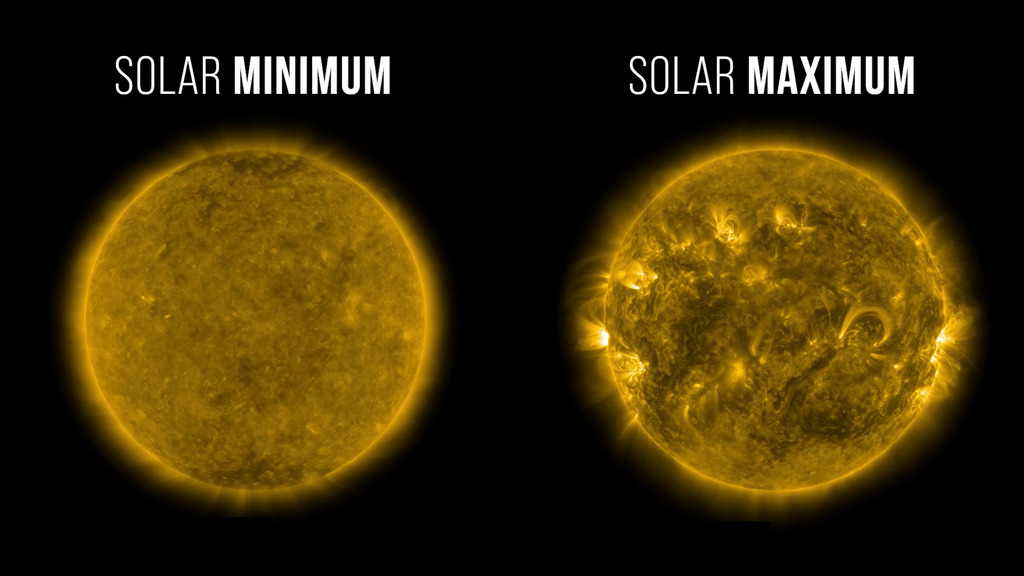


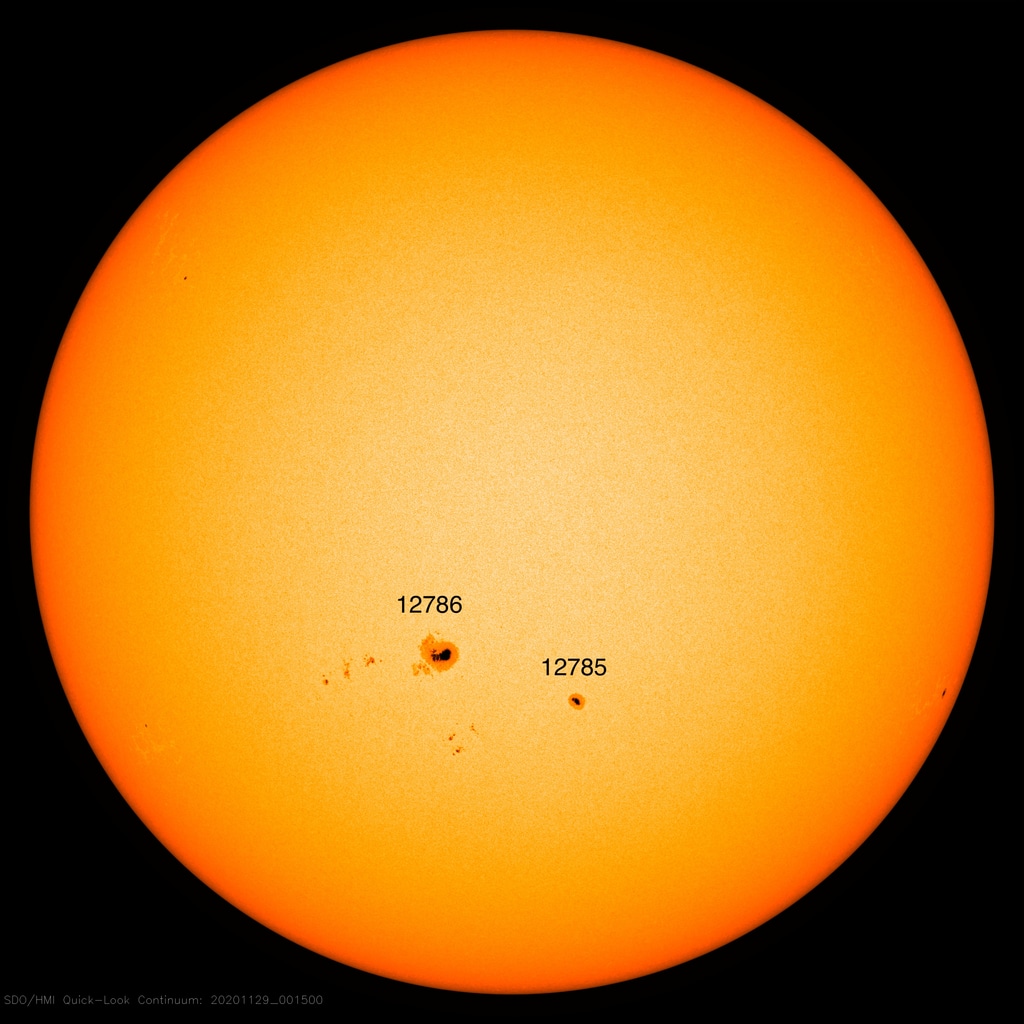
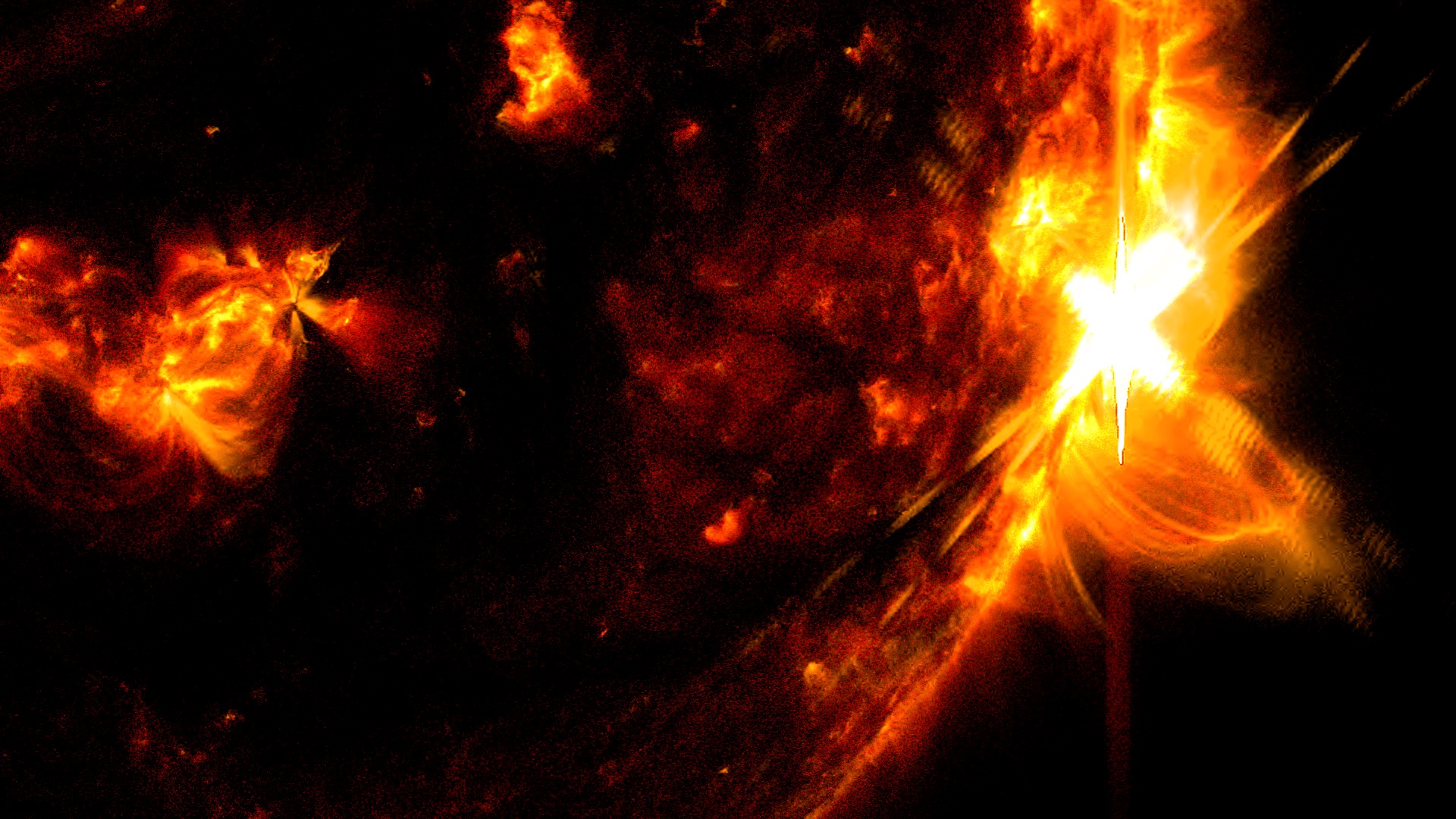


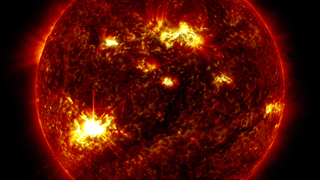
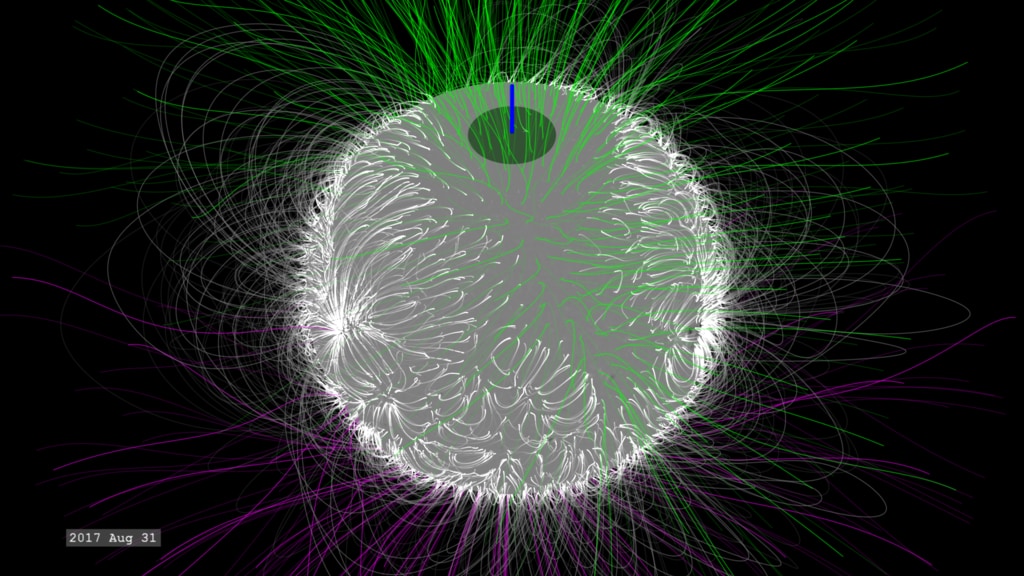
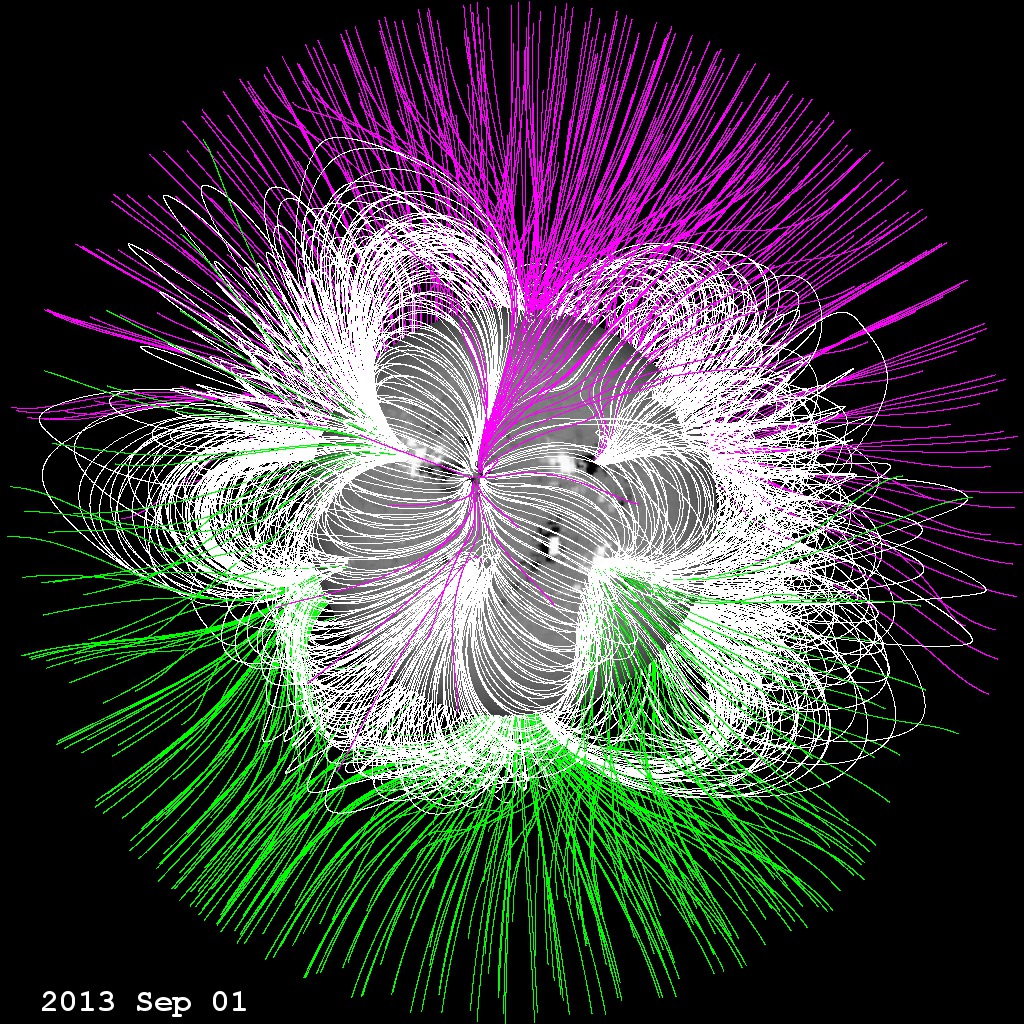
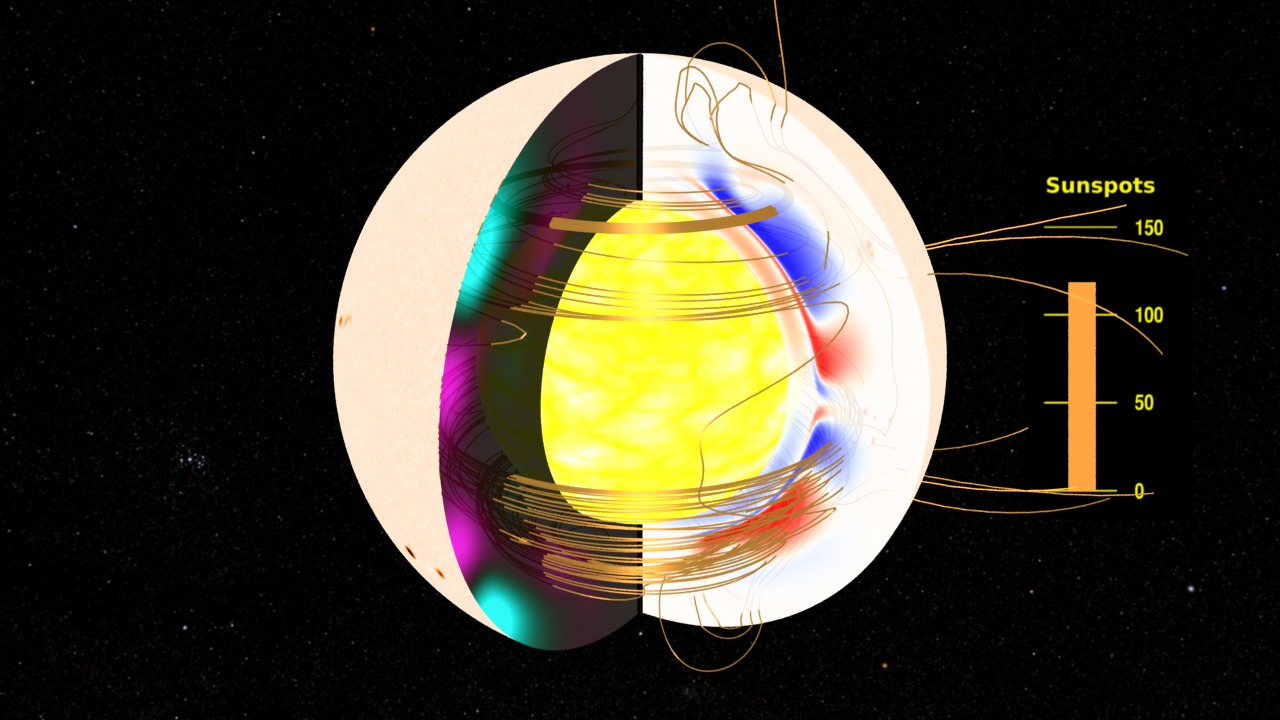
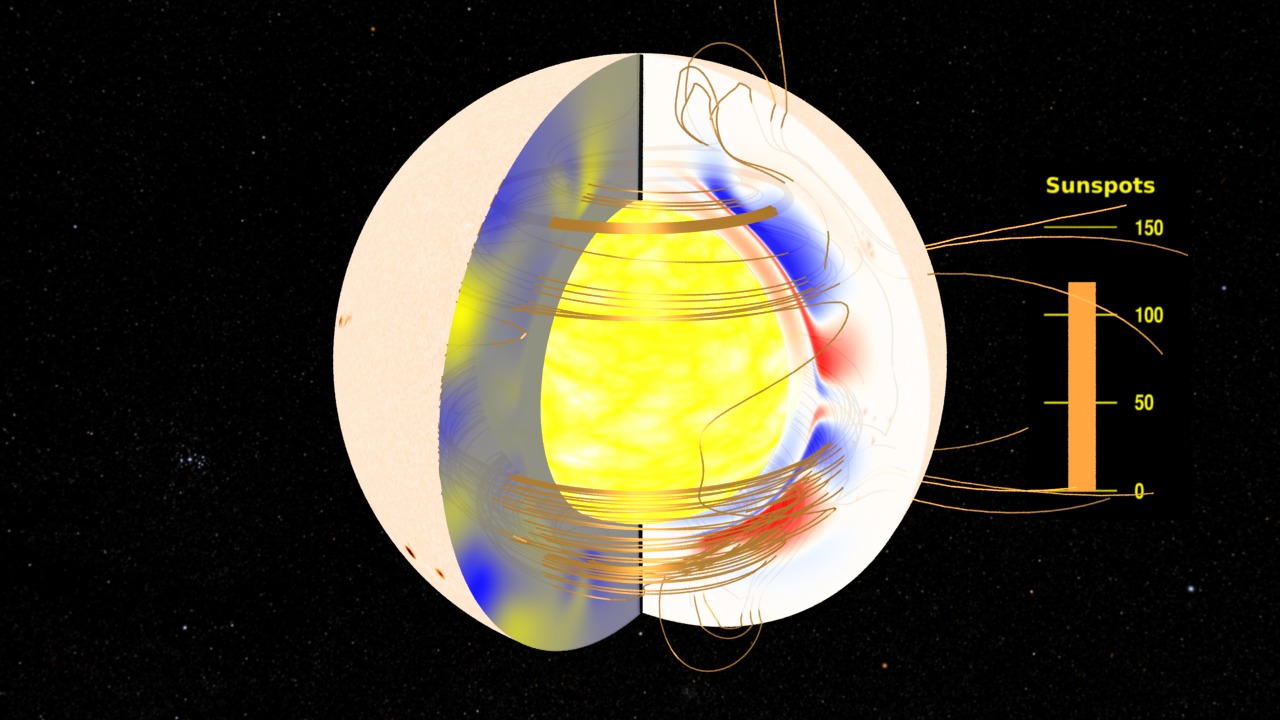


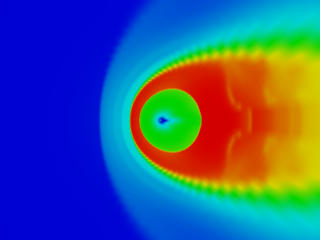
![Watch this video on the NASA Goddard YouTube channel.Complete transcript available.Music credits: “Infinite” by Joseph Pincus [ASCAP]; “Reflective Sensations”, “Ideas For Tomorrow”, “Think Tank” by Laurent Dury [SACEM]; “Wonderful Orbit” by Tom Furse Fairfax Cowan [PRS]](/vis/a010000/a013700/a013715/13715_TrackSolarCycle_YouTube.00284_print.jpg)
![16:9 Landscape Version with HBY Logo and NASA MeatballMusic Credit: “Society News Bed Instrumental” by Jean-Francois Berger [SACEM] via Universal Production Music](/vis/a010000/a014600/a014685/thumbnail_design.png)
![VIDEO IN ENGLISH Watch this video on the NASA Goddard YouTube channel.The Sun is stirring from its latest slumber. As sunspots and flares, signs of a new solar cycle, bubble from the Sun’s surface, scientists are anticipating a flurry of solar activity over the next few years. Roughly every 11 years, at the height of this cycle, the Sun’s magnetic poles flip—on Earth, that’d be like the North and South Poles’ swapping places every decade—and the Sun transitions from sluggish to active and stormy. At its quietest, the Sun is at solar minimum; during solar maximum, the Sun blazes with bright flares and solar eruptions. In this video, view the Sun's disk from our space telescopes as it transitions from minimum to maximum in the solar cycle.Music credit: "Observance" by Andrew Michael Britton [PRS], David Stephen Goldsmith [PRS] from Universal Production Music](/vis/a010000/a013700/a013716/13716_SolarCycleFromSpace_YouTube.01410_print.jpg)
![Watch this video on the NASA Goddard YouTube channel.Music credits: “End of Days - Joe Mason Remix” by Connor Shambrook [BMI], Cyrus Reynolds [BMI], Flynn Hase Spence [ASCAP], Joseph Scott Mason [APRA]; “Brainstorming” by Laurent Dury [SACEM]; “Flight of the Leaf Remix” by Julie Gruss [GEMA], Laurent Dury [SAXEM]; “Ticks and Thoughts” by Laurent Dury [SACEM]; “Intimate Journey” by Laurent Vernerey [SACEM], Nicolas de Ferran [SACEM] from Universal Production MusicComplete transcript available.](/vis/a010000/a013600/a013642/13642_IBEX11years_YouTube.00214_print.jpg)
